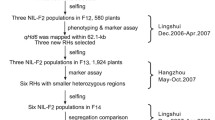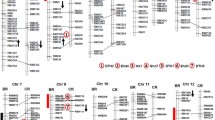Abstract
Late flowering sometimes occurs in F1 hybrids between rice varieties (Oryza sativa L.), although the parental varieties show similar days-to-flowering (DTF). The genetic architecture prompting the occurrence of such late flowering is poorly understood. To clarify the genetic architecture of late flowering in F1 hybrids from a cross between rice varieties, ‘Koshihikari’ and ‘IR64’, we performed quantitative trait locus (QTL) analysis using an F2 population (selfed progeny of an F1 plant), in which heterozygous genotypes should segregate in a certain proportion in a Mendelian manner. The QTL analysis detected three significant QTLs. At one QTL (putatively Heading date 1), the ‘Koshihikari’ allele increased DTF, and at the other two QTLs (putatively Heading date 6 and Oryza sativa Pseudo-Response Regulator 37/Heading date 2), the ‘IR64’ alleles increased DTF. All alleles at these three QTLs showed partial dominance. The combination of the QTLs explained 82.2% of the total phenotypic variance of DTF in the F2 population, with contribution from epistasis between QTLs. There was no difference between DTFs of F1 hybrids and heterozygous genotypes for the three QTLs. Our results demonstrated that the complementary effects accompanied by epistasis of at least three QTLs were responsible for late flowering in F1 hybrids.



Similar content being viewed by others
References
Birchler JA, Yao H, Chudalayandi S, Vaiman D, Veitiac RA (2010) Heterosis. Plant Cell 22:2105–2212
Cai CM, Li WM, Zhou YC (1987) Complementary genes controlling photoperiod sensitivity in hybrid rice. Rice Genet Newslett 4:90–91
Doi K, Izawa T, Fuse T, Yamanouchi U, Kubo T, Shimatani Z, Yano M, Yoshimura A (2004) Ehd1, a B-type response regulator in rice, confers short-day promotion of flowering and controls FT-like gene expression independently of Hd1. Genes Dev 18:926–936
Du A, Tian W, Wei M, Yan W, He H, Zhou D, Huang X, Li S, Ouyang X (2017) The DTH8-Hd1 module mediates day-length-dependent regulation of rice flowering. Mol Plant 10:948–961
Fukuoka S, Nonoue Y, Yano M (2010) Germplasm enhancement by developing advanced plant materials from diverse rice accessions. Breed Sci 60:509–517
Gao H, Jin M, Zheng XM et al (2014) Days to heading 7, a major quantitative locus determining photoperiod sensitivity and regional adaptation in rice. Proc Natl Acad Sci USA 111:16337–16342
Garcia AAF, Wang S, Melchingerand AE, Zeng ZB (2008) Quantitative trait loci mapping and the genetic basis of heterosis in maize and rice. Genetics 180:1707–1724
Goff SA, Zhang Q (2013) Heterosis in elite hybrid rice: speculation on the genetic and biochemical mechanisms. Curr Opin Plant Biol 16:221–227
Gu XY, Foley ME, Chen ZX (2004) A set of three genes regulates photoperiodic responses of flowering in rice (Oryza sativa). Genetica 122:127–140
Hori K, Ogiso-Tanaka E, Matsubara K, Yamanouchi U, Ebana K, Yano M (2013) Hd16, a gene for casein kinase I, is involved in the control of rice flowering time by modulating the day-length response. Plant J 76:36–46
Hori K, Nonoue Y, Ono N et al (2015) Genetic architecture of variation in heading date among Asian rice accessions. BMC Plant Biol 15:115
Huang X, Yang S, Gong J et al (2016) Genomic architecture of heterosis for yield traits in rice. Nature 537:629–633
International Rice Genome Sequencing Project (2005) The map-based sequence of the rice genome. Nature 436:793–800
Itoh H, Wada KC, Sakai H, Shibasaki K, Fukuoka S, Wu J, Yonemaru J-I, Yano M, Izawa T (2018) Genomic adaptation of flowering-time genes during the expansion of rice cultivation area. Plant J 94:895–909
Jones JW (1928) Inheritance of earliness and other agronomic characters in rice. J Agric Res 36:581–601
Kobayashi A, Hori K, Yamamoto T (2018) Koshihikari: a premium short-grain rice cultivar—its expansion and breeding in Japan. Rice 11:15
Kojima S, Takahashi Y, Kobayashi Y, Monna L, Sasaki T, Araki T, Yano M (2002) Hd3a, a rice ortholog of the Arabidopsis FT gene, promotes transition to flowering downstream of Hd1 under short-day conditions. Plant Cell Physiol 43:1096–1105
Koo BH, Yoo SC, Park JW, Kwon CT, Lee BD, An G, Zhang Z, Li J, Li Z, Paek NC (2013) Natural variation in OsPRR37 regulates heading date and contributes to rice cultivation at a wide range of latitudes. Mol Plant 6:1877–1888
Kudo M (1968) Genetical and thremmatological studies of characters, physiological or ecological, in the hybrids between ecological rice groups. Bull Nat Inst Agric Sci Ser D 19:1–84 (in Japanese with English summary)
Lander ES, Green P, Abrahamson J, Barlow A, Daly MJ, Lincoln SE, Newburg L (1987) Mapmaker: an interactive computer package for constructing primary genetic linkage maps of experimental and natural populations. Genomics 1:174–181
Li ZK, Luo LJ, Mei HW et al (2001) Overdominant epistatic loci are the primary genetic basis of inbreeding depression and heterosis in rice. I. Biomass grain yield. Genetics 158:1737–1753
Liu S, Wang F, Gao LJ, Li JH, Li RB, Gao HL, Deng GF, Yang JS, Luo XJ (2012) Genetic analysis and fine mapping of LH1 and LH2, a set of complementary genes controlling late heading in rice (Oryza sativa L.). Breed Sci 62:310–319
Liu C, Song G, Zhou Y, Qu X, Guo Z, Liu Z, Jiang D, Yang D (2015) OsPRR37 and Ghd7 are the major genes for general combining ability of DTH, PH and SPP in rice. Sci Rep 5:1–11
Luo LJ, Li ZK, Mei HW, Shu QY, Tabien R, Zhong DB, Ying CS, Stanse JW, Khush GS, Paterson AH (2001) Overdominant epistatic loci are the primary genetic basis of inbreeding depression and heterosis in rice. II. Grain yield components. Genetics 158:1755–1771
Mackill DJ, Khush GS (2018) IR64: a high-quality and high-yielding mega variety. Rice 11:18
Matsubara K, Yano M (2018) Genetic and molecular dissection of flowering time control in rice. In: Sasaki T, Ashikari M (eds) Rice genomics, genetics and breeding. Springer, Singapore, pp 177–190
Matsubara K, Kono I, Hori K et al (2008) Novel QTLs for photoperiodic flowering revealed by using reciprocal backcross inbred lines from crosses between japonica rice cultivars. Theor Appl Genet 117:935–945
Murray MG, Thompson WF (1980) Rapid isolation of high molecular weight plant DNA. Nucleic Acids Res 8:4321–4325
Nelson RJ, Denlinger DL, Somers DE (eds) (2010) Photoperiodism: the biological calendar. Oxford University Press, Oxford
Nemoto Y, Nonoue Y, Yano M, Izawa T (2016) Hd1, a CONSTANS ortholog in rice, functions as an Ehd1 repressor through interaction with monocot-specific CCT-domain protein Ghd7. Plant J 86:221–233
Nomura M, Yamazaki R (1925) A study on the inheritance of the shooting time in the rice-plant. Jpn J Genet 3:114–130 (in Japanese with English summary)
Ogiso E, Takahashi Y, Sasaki T, Yano M, Izawa T (2010) The role of casein kinase II in flowering time regulation has diversified during Evolution. Plant Physiol 152:808–820
Rieseberg LH, Raymond O, Rosenthal DM, Lai Z, Livingstone K, Nakazato T, Durphy JL, Schwarzbach AE, Donovan LA, Lexer C (2003) Major ecological transitions in wild sunflowers facilitated by hybridization. Science 301:1211–1216
Shibaya T, Nonoue Y, Ono N, Yamanouchi U, Hori K, Yano M (2011) Genetic interactions involved in the inhibition of heading by heading date QTL, Hd2 in rice under long-day conditions. Theor Appl Genet 123:1133–1143
Shrestha R, Gómez-Ariza J, Brambilla V, Fornara F (2014) Molecular control of seasonal flowering in rice, arabidopsis and temperate cereals. Ann Bot 114:1445–1458
Smith ML, Glass GV (1977) Meta-analysis of psychotherapy outcome studies. Am Psychol 32:752–760
Song G, Guo Z, Liu Z, Qu X, Jiang D, Wang W, Zhu Y, Yang D (2014) The phenotypic predisposition of the parent in F1 hybrid is correlated with transcriptome preference of the positive general combining ability parent. BMC Genom 15:1–11
Song YH, Shim JS, Kinmonth-Schultz HA, Imaizumi T (2015) Photoperiodic flowering: time measurement mechanisms in leaves. Annu Rev Plant Biol 66:441–464
Takahashi Y, Shomura A, Sasaki T, Yano M (2001) Hd6, a rice quantitative trait locus involved in photoperiod sensitivity, encodes the alpha subunit of protein kinase CK2. Proc Natl Acad Sci USA 98:7922–7927
Tamaki S, Matsuo S, Wong HL, Yokoi S, Shimamoto K (2007) Hd3a protein is a mobile flowering signal in rice. Science 316:1033–1036
Tanksley SD (1993) Mapping polygenes. Annu Rev Genet 27:205–233
Tsuji H, Taoka KI, Shimamoto K (2013) Florigen in rice: complex gene network for florigen transcription, florigen activation complex, and multiple functions. Curr Opin Plant Biol 16:228–235
Venu RC, Ma J, Jia Y et al (2014) Identification of candidate genes associated with positive and negative heterosis in rice. PLoS ONE 9(4):e95178
Vergara B, Chang T (1985) The flowering response of the rice plant to photoperiod: a review of the literature, 4th edn. IRRI, Los Baños
Wang S, Basten CJ, Zeng ZB (2012) Windows QTL cartographer 2.5. North Carolina State University, Department of Statistics, Raleigh
Yamamoto T, Lin H, Sasaki T, Yano M (2000) Identification of heading date quantitative trait locus Hd6 and characterization of its epistatic interactions with Hd2 in rice using advanced backcross progeny. Genetics 154:885–891
Yano M, Harushima Y, Nagamura Y et al (1997) Identification of quantitative trait loci controlling heading date in rice using a high-density linkage map. TAG Theor Appl Genet 95:1025–1032
Yano M, Katayose Y, Ashikari M et al (2000) Hd1, a major photoperiod sensitivity quantitative trait locus in rice, is closely related to the Arabidopsis flowering time gene CONSTANS. Plant Cell 12:2473–2484
Zhou H, Xia D, Zeng J, Jiang G, He Y (2017) Dissecting combining ability effect in a rice NCII-III population provides insights into heterosis in indica-japonica cross. Rice 10:39
Acknowledgements
The authors thank Ms. Kanako Takeyama for her assistance. This work was supported by a grant from the Ministry of Agriculture, Forestry and Fisheries of Japan (Integrated Research Project for Plant, Insect and Animal using Genome Technology QT-1005 and Genomics for Agricultural Innovation NVR-0001 to M. Y.).
Author information
Authors and Affiliations
Corresponding authors
Ethics declarations
Conflict of interest
All authors declare that they have no conflict of interest.
Additional information
Publisher's Note
Springer Nature remains neutral with regard to jurisdictional claims in published maps and institutional affiliations.
Electronic supplementary material
Below is the link to the electronic supplementary material.
Rights and permissions
About this article
Cite this article
Matsubara, K., Ando, T. & Yano, M. Late flowering in F1 hybrid rice brought about by the complementary effect of quantitative trait loci. Genetica 147, 351–358 (2019). https://doi.org/10.1007/s10709-019-00075-1
Received:
Accepted:
Published:
Issue Date:
DOI: https://doi.org/10.1007/s10709-019-00075-1




